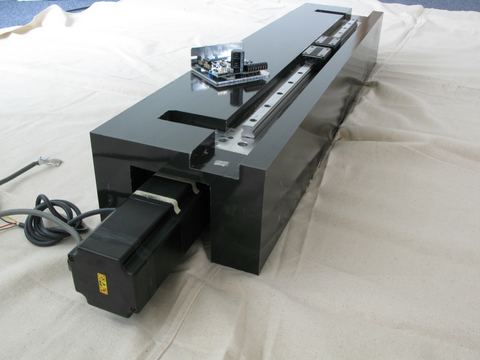 | ||
Epoxy granite, also known as synthetic granite, is a mixture of epoxy and granite commonly used as an alternative material for machine tool bases. Epoxy granite is used instead of cast iron and steel for better vibration damping, longer tool life, and lower assembly cost.
Contents
Machine tool base
Machine tools and other high-precision machines rely upon high stiffness, long-term stability, and excellent damping characteristics of the base material for their static and dynamic performance. The most widely used materials for these structures are cast iron, welded steel fabrications, and natural granite. Due to the lack of long-term stability and very poor damping properties, steel fabricated structures are seldom used where high precision is required. Good-quality cast iron that is stress-relieved and annealed will give the structure dimensional stability, and can be cast into complex shapes, but needs an expensive machining process to form precision surfaces after casting.
Good-quality natural granite is becoming more and more difficult to find, but has a higher damping capacity than cast iron. Again, as with cast iron, the machining of natural granite is labour-intensive and expensive.
Process
Precision granite castings are produced by mixing granite aggregates (which are crushed, washed, and dried) with an epoxy resin system at ambient temperature (i.e., cold curing process). Quartz aggregate filler can also be used in the composition. Vibratory compaction during the molding process tightly packs the aggregate together.
Threaded inserts, steel plates, and coolant pipes can be cast-in during the casting process. To achieve an even higher degree of versatility, linear rails, ground slide-ways and motor mounts can be replicated or grouted-in, therefore eliminating the need for any post-cast machining. The surface finish of the casting is as good as the mould surface.
Advantages and disadvantages
Advantages include:
Epoxy granite material has an internal damping factor up to ten times better than cast iron, up to three times better than natural granite, and up to thirty times better than steel fabricated structure. It is unaffected by coolants, has excellent long-term stability, improved thermal stability, high torsional and dynamic stiffness, excellent noise absorption, and negligible internal stresses.
Disadvantages include low strength in thin sections (less than 1 in (25 mm)), low tensile strength, and low shock resistance.
History
Although new to many machine tool builders, especially those in the United States, the composite base has been available in Europe for several years. Fritz Studer AG of Switzerland first came up with its Granitan S-100 technology in the early 1970s. The Granitan base is a mixture of reactable epoxy-resin binder developed by Ciba-Geigy Ltd., Switzerland, and granite or gravel. Granitan produced with sand and gravel was developed specifically for the requirements of machine structure manufacturing.
